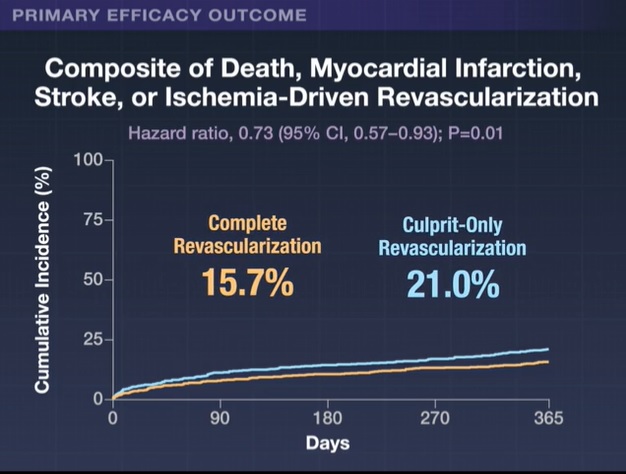Background
The benefit of complete revascularization in older patients (≥75 years) with myocardial infarction and multivessel disease remains unclear.
Methods
In this multicenter randomized trial, we assigned older patients with myocardial infarction and multivessel disease undergoing percutaneous coronary intervention (PCI) of the culprit lesion to receive physiology-guided complete revascularization of the non-culprit lesions or no further revascularization.
- Functionally significant nonculprit lesions were identified by differential pressure catheterization or angiography.
- The primary outcome was a composite of death, myocardial infarction, stroke, or any revascularization at 1 year.
- The key secondary outcome was a composite of cardiovascular death or myocardial infarction.
- Safety was assessed as a composite of contrast-associated acute kidney injury, stroke, or hemorrhage .
Results
A total of 1,445 patients underwent randomization (720 to receive complete revascularization and 725 to receive culprit-only revascularization).
The median age of patients was 80 years (interquartile range, 77 to 84); 528 patients (36.5%) were women and 509 (35.2%) were admitted for ST-segment elevation myocardial infarction.
A primary outcome event occurred in 113 patients (15.7%) in the complete revascularization group and 152 patients (21.0%) in the culprit-only group (hazard ratio, 0.73; 95% confidence interval [CI], 0.57 to 0.93). ; P = 0.01).
Cardiovascular death or myocardial infarction occurred in 64 patients (8.9%) in the complete revascularization group and in 98 patients (13.5%) in the culprit-only group (hazard ratio, 0.64; CI 95%, 0.47 to 0.88).
The safety outcome did not appear to differ between the groups (22.5% vs. 20.4%; P = 0.37).

Conclusions Among patients 75 years of age or older with myocardial infarction and multivessel disease, those who underwent physiology-guided complete revascularization had a lower risk of death, myocardial infarction, stroke, or ischemia-driven revascularization at 1 year than those who received PCI only for the culprit lesion . |
(Funded by Consorzio Futuro en Ricerca et al.; FIRE ClinicalTrials.gov number, NCT03772743. opens in new tab.)
















